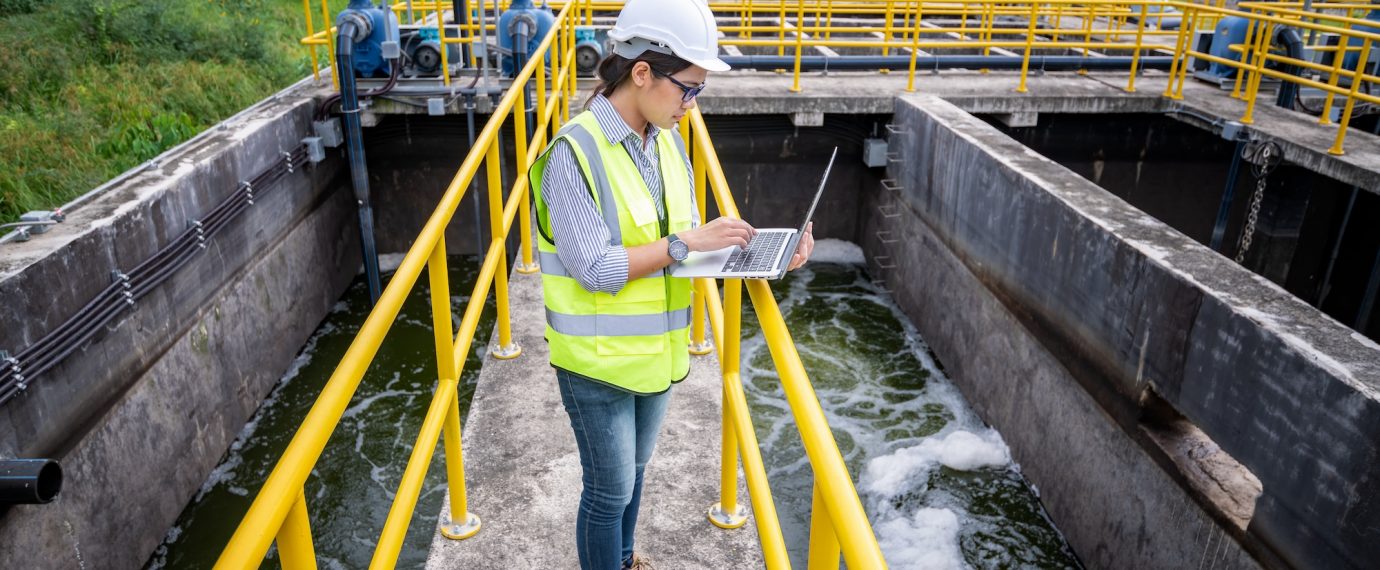By Sam Anderson, Supervisor – Environmental, U.S. Compliance
As regulatory agencies intensify their focus on environmental protection, Per- and Polyfluoroalkyl Substances (PFAS) have become a critical concern in water management. These persistent and potentially harmful chemicals are subject to increasing regulation at both federal and state levels, particularly in relation to drinking water, wastewater, and stormwater discharges. For manufacturers and industrial operators, understanding and complying with evolving PFAS requirements is essential to avoid penalties and ensure long-term environmental stewardship.
This article provides a comprehensive overview of PFAS chemicals, current and emerging water regulations, and practical guidance on how manufacturing facilities can identify sources of PFAS and implement compliant water management strategies.
What Are PFAS Chemicals?
PFAS (Per- and Polyfluoroalkyl Substances) are a group of over 12,000 synthetic chemicals used since the 1940s in a wide range of industrial and consumer applications due to their heat resistance, chemical stability, and water-repellent properties. Common products that contain PFAS include non-stick cookware, firefighting foams, water-resistant clothing, food packaging, and electronics.
PFAS are often referred to as “forever chemicals” because they do not readily break down in the environment or the human body. As a result, PFAS can accumulate over time and have been associated with adverse health effects, including liver damage, immune system disruption, developmental issues, and increased cancer risk.
Inventorying PFAS Chemicals
The scope of PFAS is vast—nearly 15,000 compounds have been identified to date. The EPA tracks these chemicals through its CompTox Chemicals Dashboard, a valuable tool that helps facilities understand which substances may be regulated or subject to scrutiny. As new compounds are studied and added to regulatory frameworks, it’s critical for manufacturers to maintain an updated inventory of PFAS-related materials used on-site.
PFAS Water Regulations
Recognizing the health and environmental risks, federal and state agencies have begun implementing increasingly stringent PFAS regulations. These include enforceable limits for PFAS in drinking water and specific monitoring, reporting, and treatment requirements for wastewater and stormwater discharges.
Regulations continue to evolve rapidly, and many states have adopted their own PFAS standards that are more restrictive than federal guidelines. Manufacturing facilities must remain proactive in monitoring regulatory developments to ensure ongoing compliance.
EPA’s PFAS Drinking Water Standards Paused Amid Legal Review
In April 2024, the U.S. Environmental Protection Agency (EPA) announced groundbreaking national drinking water standards targeting six PFAS compounds for the first time. These standards set enforceable limits under the Safe Drinking Water Act, aiming to reduce public exposure to these persistent and potentially harmful chemicals.
Key highlights of the proposed standards included:
- PFOA and PFOS: A Maximum Contaminant Level (MCL) of 4 parts per trillion (ppt) for each.
- PFNA, PFHxS, PFBS, and GenX Chemicals: Regulated under a Hazard Index (HI) approach, which accounts for the combined health risks from simultaneous exposure to multiple PFAS compounds.
These standards required public water systems to conduct regular monitoring and take corrective actions—such as implementing advanced treatment technologies—if PFAS levels exceeded the regulatory thresholds.
Compliance Timeline
As originally outlined in the 2024 standard, the EPA’s final rule included a phased implementation plan:
- By 2027: Water systems were expected to complete initial PFAS monitoring and begin regular testing.
- Also by 2027: Systems would have to notify the public if PFAS concentrations exceeded limits.
- By 2029: Any water system with PFAS levels above the standards would need to take corrective action, such as installing treatment systems or finding alternative water sources.
These requirements also extended to manufacturers operating non-transient non-community water systems (NTNCWSs), who were advised to closely monitor their water use and potential source water impacts.
Legal Challenge and Ongoing Reevaluation
However, as of mid-2025, the implementation of these standards has been paused by the courts. Legal challenges have prompted a temporary halt while the EPA re-evaluates both the scientific basis and the regulatory approach behind the standards. This means the timeline for compliance—and possibly the content of the rules themselves—may be revised in the coming months.
Stakeholders, including public water systems and industrial water users, should stay informed as the situation evolves. The EPA is expected to release updates following the court’s review and any subsequent revisions to the drinking water standards.
Wastewater Regulations
Wastewater regulations are at the forefront of PFAS oversight, with increasing state efforts aimed at monitoring and controlling industrial discharges.
With Federal Action in Flux, States Take the Lead on PFAS Wastewater Regulation
Although the EPA has yet to establish enforceable numeric effluent limits for PFAS under the federal Clean Water Act, regulatory momentum is moving decisively to the state level. As federal guidance shifts and key initiatives face legal delays, states are stepping in to fill the gap with more aggressive monitoring and discharge control efforts.
In 2022, the EPA issued guidance recommending that National Pollutant Discharge Elimination System (NPDES) permit writers include PFAS monitoring requirements for industrial dischargers and publicly owned treatment works (POTWs). While this guidance stopped short of enforceable limits, many states have taken concrete steps to act on these recommendations—and, in some cases, go further.
The Acceleration of State-Level Action
Several states have already incorporated PFAS-related requirements into industrial wastewater permitting programs, setting a precedent that others are rapidly following:
- Michigan and North Carolina now require industrial users to monitor—and in some cases, reduce—PFAS discharges to POTWs. These states have built targeted pretreatment programs aimed at identifying and controlling upstream contributors to PFAS pollution.
- California has added PFAS monitoring requirements under its Industrial General Permit (IGP) for stormwater, focusing on high-risk sectors.
As more POTWs begin conducting their own PFAS sampling, facilities that discharge to municipal systems are likely to face increased scrutiny. These systems are under pressure to trace PFAS back to their sources, leading to more frequent outreach and sampling requests directed at upstream contributors.
Stormwater Regulations
Alongside wastewater efforts, PFAS regulation in stormwater is also gaining momentum. While not yet widespread, state agencies are beginning to incorporate PFAS monitoring into stormwater permits, particularly for high-risk sectors like metal finishing, landfills, and chemical manufacturing.
In regions with known PFAS contamination, stormwater discharges may require monitoring or source control plans. Facilities covered under industrial stormwater permits should evaluate whether PFAS-related requirements apply and prepare accordingly.
Source Identification
To develop an effective PFAS management plan, facilities must first identify where these substances are used or generated. PFAS may be introduced through products, industrial processes, storage practices, or legacy contamination from historical activities.
Identifying these pathways is critical for designing monitoring programs and treatment solutions that meet emerging regulatory demands.
How to Identify Possible PFAS Sources at Your Manufacturing Facility
- Inventory Chemicals and Products: Review Safety Data Sheets (SDS) and purchasing records for raw materials, cleaners, coatings, and lubricants. Look for indications of fluorinated or surfactant compounds, which may suggest PFAS content.
- Reach out to Chemical Suppliers: Contact your suppliers to confirm whether products are PFAS-free or if PFAS are intentionally added. Request documentation or certifications as part of your product review process.
- Assess Past and Current Processes: Examine historical operations that may have used PFAS-containing materials, such as plating, degreasing, or waterproofing. Consider legacy contamination from past tenants or activities.
- Evaluate On-site Waste Management: Inspect areas where wastewater, rinse water, or stormwater may come into contact with PFAS sources. This includes storage tanks, floor drains, containment systems, and outdoor operations.
- Consult Industry Resources: Refer to EPA’s PFAS Analytic Tools, state-specific PFAS guidance, and trade associations for industry-specific insights into potential PFAS sources.
Common PFAS Sources Across Industries
PFAS usage varies by sector, but common industry sources include:
- Chemical Manufacturing
- PFAS are used in the lining of reaction vessels, chemical-resistant coatings, and seals for rotary and centrifugal pumps.
- Applications include valves, fittings, o-rings, and sulfur trioxide spill control mixtures.
- Glass Manufacturing and Coating
- PFAS-containing products may be used as glass surface cleaners, drying solvents, and etching/polishing agents.
- Surface treatments for water and oil repellency may also involve PFAS.
- Plastic and Rubber Manufacturing
- Common sources include etching agents, foam blowing agents, mold release sprays, plastic resins, and processing aids.
- PFAS may also be used in flame retardants or to improve flow properties during extrusion.
- Metal Finishing and Plating
- PFAS-based mist suppressants are frequently used in chrome, nickel, tin, copper, and zinc plating.
- Other sources include anodizing processes, metal cleaners, corrosion inhibitors, and repellent coatings.
- Paper and Packaging
- PFAS are widely used in grease- and water-resistant coatings on paper, cardboard, bags, boxes, trays, and food packaging.
- Additional uses include baking paper, coated drums, and machinery lubricants used in packaging systems.
- Food and Beverage Manufacturing
- PFAS may be found in conveyor belts, guide rails, valves, fitments, and non-stick ovenware.
- They are also used in lubricants for equipment and coatings that contact food surfaces.
- Personal Care Products
- PFAS are found in formulations of lotions, creams, makeup, deodorants, hair care products, lip balm, toothpaste, and dental floss to enhance texture, spreadability, and water resistance.
- Biotechnology and Pharmaceutical Manufacturing
- PFAS may be used in sterile containers, ultrafiltration membranes, and microporous filters essential for cell cultivation and bioprocessing.
Understanding these common sources can help facilities anticipate areas of concern even if direct PFAS use is not apparent.
PFAS Sampling
Sampling for PFAS requires a high level of precision and contamination control. Whether collecting samples for drinking water, stormwater, or wastewater, it’s critical to follow EPA-approved methods and laboratory protocols.
Key Considerations for PFAS Sampling:
- Use PFAS-Free Equipment: Sampling gear, bottles, gloves, and containers must be free of PFAS to prevent sample contamination.
- Avoid Consumer Products Containing PFAS: Don’t use Teflon tape, waterproof clothing, or personal care products during sampling activities.
- Work with Certified Laboratories: Choose labs accredited for PFAS analysis using EPA Method 537.1, 533, or 1633, depending on the matrix.
Many regulatory agencies now require facilities to submit PFAS sampling results as part of compliance reporting. Establishing a PFAS monitoring plan can help identify trends, verify treatment effectiveness, and demonstrate due diligence.
How to Remove PFAS from Your Facility
Once PFAS sources are identified, proactive removal strategies are essential to protect water quality and achieve regulatory compliance.
1. Eliminate or Substitute PFAS-Containing Materials
- Review purchasing practices and replace PFAS-containing products with safer alternatives when available.
- Work with suppliers to verify product content and request PFAS-free certifications.
2. Improve Operational Controls
- Isolate or eliminate processes that use PFAS, such as certain plating or coating operations.
- Install secondary containment for areas where PFAS materials are stored or handled to prevent spills and runoff.
3. Implement Treatment Technologies
- Install a wastewater treatment system to treat the PFAS out of the water prior to discharge.
4. Develop a PFAS Management Plan
- Include regular monitoring, employee training, and process audits.
- Document removal activities and results to demonstrate due diligence and regulatory compliance.
Removing PFAS is often a long-term endeavor, but taking proactive steps now can reduce liabilities and demonstrate your facility’s commitment to environmental stewardship.
Conclusion
PFAS regulations are rapidly reshaping water management requirements for manufacturers and industrial facilities. With enforceable drinking water standards in place and growing scrutiny of wastewater and stormwater discharges, it is imperative for EHS teams to take proactive steps toward compliance.
By understanding where PFAS are used, identifying potential sources at your facility, and implementing appropriate sampling and mitigation strategies, you can position your organization for compliance and environmental leadership.
Stay informed of regulatory updates, consult with qualified environmental professionals, and invest in source control and treatment solutions tailored to your industry. Managing PFAS may be complex, but with the right tools and knowledge, your facility can rise to the challenge.
Need help navigating PFAS regulations? Contact U.S. Compliance for a free compliance consultation and explore how our Compliance as a Service (CaaS) model can support your water management goals.



